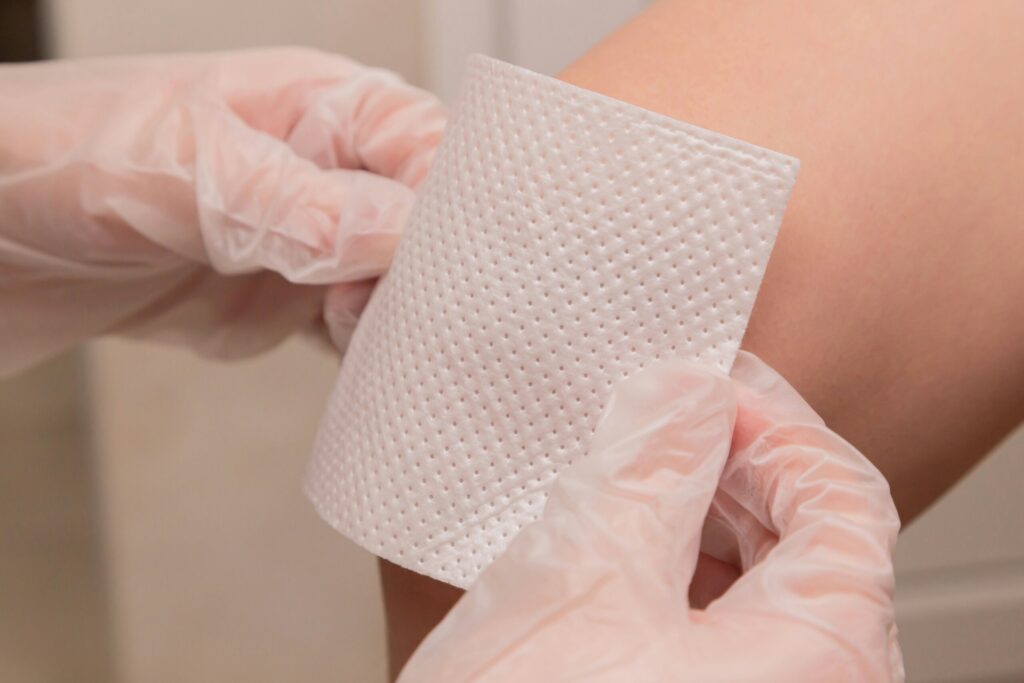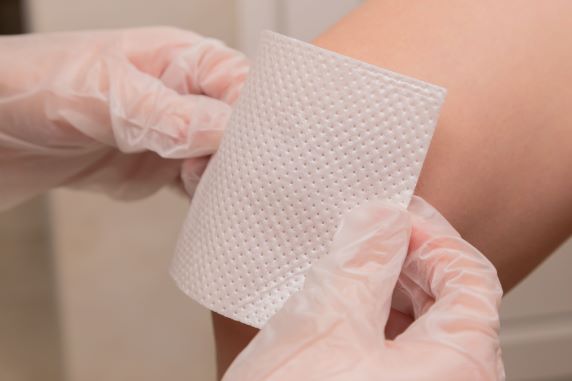Many older athletes are finding it harder to stay active because of pickleball knee pain. Now, this game is much gentler on the joints than other racket sports. However, when athletes have osteoarthritis in the knees, staying in the game can be very painful. Thankfully, GAE, or genicular artery embolization, can get you back into action.

Understanding Pickleball Knee Pain
Many pickleball players get hurt due to age-related risks. And that makes sense because Paddletek reveals that more than 50% of the 36.5 million US pickleball players are over the age of 55. And an additional 30% of players are over the age of 65.
Of course, some of the aches and pains associated with the sport are due to knee injuries such as muscle tears or ligament strains. (And the risk for those injuries increases if age has already put mobility limits on your joints.) Now, some of these injuries can be avoided with proper form, lots of stretching, and supportive athletic gear. But when pickleball knee pain is caused by osteoarthritis, many players can find from an alternative knee replacement procedure called GAE.
This procedure was a game-saver for 80-year-old Patrick Shruben, who recently discussed undergoing GAE in 2021 with UCLA Health. The older athlete needed to relieve his pickleball knee pain, but “did not want to sit in pain for months after surgery.” After researching his relief options, Shruben chose GAE, saying, "My treatment was pretty amazing. I walked without knee pain the next day.”
Even better? His GAE procedure was very effective, as Shruben is still feeling great more than two years later. Even now, he brags, “Here I am at 80, and I’m doing things my own children can’t do.”
Choosing GAE at the Georgia Knee Institute
Ready to say goodbye to pickleball knee pain? Do you want osteoarthritis knee pain relief without surgery? Click here to request an appointment. When you come into the office, we'll determine if you're a good candidate for GAE and come up with your customized treatment plan.
Ready to relieve osteoarthritis' chronic pain and swelling surgery? You need an alternative knee replacement, whether you're simply not a surgical candidate, or prefer to delay a knee replacement due to your age. Of course, we can't cure your arthritis. But we can offer relief for pain, stiffness and swelling. And we can help keep you mobile and active, without going under the knife. Here's how.

Lifestyle Remedies for Knee Pain
When osteoarthritis knee pain is mild, you may find relief from noninvasive interventions. You can begin by losing weight, if necessary, to relieve pressure on the joints in your knee and to help prevent further damage to your cartilage.
You should also try to stay active, either through physical therapy or with low-impact exercises like walking or swimming. Finally, over-the-counter medications can help relieve inflammation and pain. But they may cause additional side effects, so be sure to clear this option with your healthcare provider.
Alternative Knee Replacement: Medical Interventions
If you want to temporarily relieve osteoarthritis knee pain without surgery, you may benefit from knee injections of cortisone or hyaluronic acid. These interventions can relieve inflammation and lubricate your joints to preserve mobility, but effects don't usually last more than a few months.
Luckily, there's an alternative knee replacement that offers at least a year of pain relief: genicular artery embolization, or GAE. This procedure relieves osteoarthritis knee pain by blocking blood flow to the joint. This reduces pain and inflammation, and slow arthritis progression, helping you delay knee replacement surgery.
Ready to see if GAE is the right alternative knee replacement for you? Patients with moderate to severe pain who are in good health, haven't found relief from non-invasive treatments, and are 40-80 years of age are considered good GAE candidates. Click here to request an appointment with the Georgia Knee Institute to discuss next steps!
In the Georgia Knee Institute we relieve osteoarthritis-related knee pain with genicular artery embolization, or GAE. This minimally invasive procedure reduces your pain and improves mobility by cutting off blood flow to the lining of your knee, getting rid of inflammation there. Now, many patients come in to this office, seeking relief without invasive surgery. But, before scheduling their procedure, they do have one key question: what's the genicular artery embolization recovery time? Here's what you need to know.

Genicular Artery Embolization: Recovery Time After Your Procedure
The length of your GAE procedure will be around 1-2 hours. (Explore the ins and outs of this procedure here.) Immediately after your procedure, you will spend a few hours in the recovery room under observation. Most of our patients will be able to walk within two to three hours of the procedure's completion and should be able to go home on the same day.
The day after GAE, you'll be able to resume light activities, and within two or three days, you'll be ready to get back to your normal routine. (You should still avoid heavy activity for about two weeks while you recover from GAE.) At that point, the results of your procedure, including arthritis pain relief, should be noticeable.
How Long Does it Take to Recover From Genicular Artery Embolization?
Any side effects associated with GAE are minor, including mild bruising or slight changes to the appearance of your skin. These effects should be resolved, and you should be able to resume all activities, within two weeks of GAE. After that, your genicular artery embolization recovery should be complete, and you will start to appreciate the benefits of your procedure.
These include,
- Reduced swelling and pain in your knee
- Less stiffness
- Functional improvements in mobility and joint movement
In conclusion, after your genicular artery embolization recovery, you'll experience osteoarthritis knee pain relief for up to a full year. As such, it's an ideal treatment for patients with moderate to severe arthritis pain who wish to delay or avoid full knee replacement surgery. Ready to see if this treatment will work for you? Click here to request an appointment with our knee specialists in Georgia!
Living with arthritis in the knee? Seeking treatment for arthritis knee pain? Before you explore your options, it's important to understand arthritis pain. So, let's dive in together.

Understanding Knee Arthritis
Arthritis is a disease that causes swelling and tenderness in one or more of your joints. If you have knee arthritis, joints in one or both of your knees may be affected, leading to pain, stiffness, and limits on mobility. Osteoarthritis is the most common form of disease in your knees. And, while it's progressive and incurable, the right treatments can help relieve your pain.
Is There Treatment for Arthritis Knee Pain?
Again, you can't cure osteoarthritis. But you can preserve your mobility, relieve pain and prevent or delay progression by seeking early intervention.
Some people find relief with heating pads and/or over-the-counter non-steroidal anti-inflammatories. Physical therapy and regular exercise can help you stay active and mobile. But, if those treatments fail to offer sufficient relief, and you want to delay or avoid surgery, or simply aren’t a surgical candidate, genicular artery embolization (GAE) in Georgia can provide an effective alternative to surgical treatment for arthritis knee pain.
What is Genicular Aretery Embolization?
GAE is a non-surgical procedure to slow osteoarthritis progression in the knee. Minimally invasive, and lasting about two hours, this treatment allows you to avoid hospitalization and general anesthesia.
During the procedure, our interventional radiologists administer anesthetic through a small puncture opening in the groin. Then, they use that opening to insert a thin catheter to the femoral artery, directing it to the knee’s genicular artery via X-ray image guidance.
Once in place, we release small embolic materials into your vessels, limiting blood flow to the knee lining and thereby reducing pain, inflammation and other knee arthritis symptoms. Once complete, we extract the catheter, monitor you for a few hours, and send you home. The next day, you can resume normal activities. And, within weeks of the procedure, you should experience noticeable arthritis pain relief.
Choosing GAE for Treatment of Arthritis Knee Pain in Georgia
Ready to see if you’re a candidate for GAE in Georgia? This treatment is for you if:
- You've been diagnosed with knee osteoarthritis
- Have pain and stiffness that's moderate to severe
- Aren't getting relief from medication or conservative treatments
- Are between 40 and 80 years of age, in general good health
Do you meet these criteria and are want relief from osteoarthritis knee pain? Click here to request an appointment with our experts at the Georgia Knee Institute.
An alternative knee replacement is a minimally- invasive procedure, but are there genicular artery embolization side effects? Plus, how does this procedure relieve arthritis-related knee pain without surgery? Keep reading to learn more.

Genicular Artery Embolization (GAE): An Alternative Knee Replacement
GAE relieves pain related to osteoarthritis (OA) of the knee. At the Georgia Knee Institute, our interventional radiologists perform this treatment as an outpatient procedure, using local instead of general anesthesia. This allows you to remain awake and comfortable during treatment. Plus it means you can avoid an overnight hospital stay!
But what's involved in the procedure? While you are awake but sedated, our specialists use X-ray imaging to guide a catheter to the blood vessels supplying your knee joint. Once it's in place, we can inject embolizing material into your knee lining (synovium), reducing blood flow along with pain and swelling in your knee.
Are there Genicular Artery Embolization Side Effects?
Though a relatively new treatment option, research and patient reports tell us that there aren’t significant genicular artery embolization side effects. Some patients report mild pain, bruising or discoloration around your knee after GAE. However, if you do experience these side effects, they should resolve within weeks of your GAE procedure. And they are typically mild and easy to tolerate.
Side Effects of GAE vs Benefits
As you can see, any genicular artery embolization side effects are minor and resolve without intervention. Plus, GAE has a high success rate for OA knee pain sufferers. And it comes with a relatively short recover period, in contrast to the six months to one year of recovery you can expect following knee replacement surgery.
Choosing GAE in Georgia
GAE is a great treatment option for patients who are ineligible for or wish to avoid knee replacement surgery, but haven’t found relief from treatment options such as medication or physical therapy. And, while GAE won’t cure osteoarthritis, it can provide extended OA symptom relief, helping you maintain mobility and delay or avoid surgery. Ready to see if you’re a candidate for GAE in Georgia? Click here to request an appointment.

Your knees take on a lot of wear and tear, especially as you age. For that reason, after decades of movement, you're likely to sustain damage to the smooth tissue that sits between your bones (called cartilage) allowing osteoarthritis to develop in your knees. When that happens, symptoms such as pain, stiffness and limited mobility are all common, negatively impacting your ability to enjoy life. In the past, the only true pathway to relieve this kind of knee pain was to seek surgery. Yet, today, there's new hope for relief for patients who wish to avoid surgery, or who can't undergo a knee replacement for a variety of reasons.
What is this new, non-surgical treatment for osteoarthritis of the knee? When options such as over-the-counter medications fail, patients can now find relief from the GAE knee procedure known as genicular artery embolization (GAE).
GAE Knee Procedure: How it Differs from Other Arthritis Treatments
GAE takes a new approach to relieving arthritis pain. Older treatment options relieve pain by targeting your cartilage. But the minimally invasive GAE knee procedure focuses on relieving inflammation around your knee joint.
How does this work? Well, the inside of your knee is lined by a type of connective tissue called the synovium, and that lining receives a supply of blood from the six genicular arteries. When you choose GAE, we can use guided 3D imaging to find areas of inflammation in your synovium. Then, we can insert a small catheter into your artery, guiding it to the synovium in your knee. Next, we inject small particles to reduce your arterial blood flow. As a result, we can reduce those spots of inflammation, in turn providing effective pain relief.
Best of all, unlike surgery, you can go home on the same day as your GAE knee procedure, avoiding an overnight hospital stay. While you will have to reduce your activity levels for a few days after your procedure, the recovery period is shorter and easier than ones associated with knee replacement surgery. In fact, most patients can resume normal activities within days of genicular artery embolization.
Benefits of GAE Knee Procedure
After GAE, most patients are able to avoid serious pain medications, along with the risk of dependence and additional side effects. Now, genicular artery embolization can't restore or repair your knee cartilage. However, it can delay osteoarthritis progression and offer effective pain relief and improved mobility, helping many patients avoid knee replacement surgery for extended periods of time. Ready to see if genicular artery embolization is your ideal alternative to knee replacement surgery? Click here to request an appointment at our Georgia Knee Institute. When you come in, we will determine the extent of your condition and determine if you're a candidate for this osteoarthritis treatment option.

Recently, our Georgia Knee Institute's interventional radiologists added an alternative knee replacement procedure known as Genicular Artery Embolization, or GAE. This minimally invasive procedure relieves knee inflammation and pain without surgery. It works by decreasing blood flow to the parts of your knee that osteoarthritis has damaged. But what causes osteoarthritis knee damage? And who should seek out an alternative knee replacement treatment for pain relief? Keep reading to find out!
Knee Damage and Osteoarthritis
Your knee joints should work like hinges so that you can easily bend and move. However, years of activity can wear down your knee joints and the cartilage beneath that covers up your bones. If that happens, you may develop osteoarthritis, along with pain, stiffness and limits on joint mobility.
Age is a risk factor for osteoarthritis of the knees, since the National Institutes of Health reports that 10% of men and 13% of women over 60 suffer from osteoarthritis in the knee. Most will seek pain relief, and many will hope to find it without surgery. For that reason, as an alternative knee replacement, GAE is a very popular osteoarthritis treatment option.
What to Expect with GAE as an Alternative Knee Replacement
Though it's a fairly new osteoarthritis treatment, GAE is effective because it takes a fresh approach to pain relief. In fact, it targets inflammation, not cartilage degradation, thereby slowing bone degradation due to bone-on-bone contact. In this way, you can slow disease progression while relieving pain. And you can do both without surgery!
Does GAE offer lasting relief? According to the UCLA Medical Center study, 70% of patients reported they less pain, stiffness and difficulty walking one year after GAE. Plus, because they'd tried other treatment options--and failed to find relief--they were thrilled to find an effective alternative knee replacement.
What to Expect from the Procedure
How does GAE work? During this outpatient procedure, our experts make a small incision in the crease of your leg, allowing us to access your femoral artery with a catheter. Next, we use imaging to guide the catheter to three of the seven genicular arteries that feed your knee joint's blood supply.
During the procedure, you'll be awake, allowing us to accurately target the source of your knee pain. Once that's identified, we can cut off blood flow to the arteries responsible for your pain and inflammation by inserting beads through the catheter. In total, the procedure lasts approximately two hours. After, we'll keep you for observation until we're sure you're doing well. Then, while you'll need to modify your activity levels for a few days after GAE, you can still go home that day, avoiding an overnight stay in the hospital.
Who is a Candidate for Alternative Knee Replacement?
Patients who are good candidates for genicular artery embolization have experienced at least six months of chronic knee pain. They should also try at least one other non-surgical treatment option before seeking GAE, and should not be smokers. Ready to find relief from knee pain without surgery? Contact our Georgia Knee Institute by clicking here to request an appointment.

As a new alternative to knee replacement, many people are curious about the success rate of genicular artery embolization. Well, we've got plenty of stats that prove why this minimally invasive treatment for osteoarthritis of the knee is effective. First, though, let's explain what's involved in the procedure.
What to expect with genicular artery embolization
Genicular artery embolization, or GAE, offers an alternative to knee replacement surgery. It can treat osteoarthritis pain and progression without replacing the knee joint.
Who is a good GAE candidate? This treatment option is best if you have mild arthritis, and are seeking a treatment that is less invasive than surgery but takes a more aggressive approach than treatments involving anti-inflammatory medications and physical therapy. How does it find that middle ground? Put simply, genicular artery embolization blocks the flow of blood to your hypervascular joint lining (synovium).
How does blocking blood flow relieve osteoarthritis? Here's the story: your synovium is a vascular lining. As a result, if you develop osteoarthritis in your knee, that joint lining becomes thickened and inflamed, resulting in pain. So, to relieve that pain, our Georgia Knee Institute's interventional radiologists insert a small catheter into one of the leg arteries. Then, using x-ray guidance to navigate the blood vessels, we can pinpoint the origins of inflammation. Next, we'll target the inflamed synovium sections by injecting particles to decrease blood flow to the knee. In turn, inflammation and pain reduces, and joint function improves.
Exploring the success rate of genicular artery embolization
As an alternative knee replacement, GAE offers many benefits. It reduces inflammation in your joint lining, helping slow the progression of osteoarthritis. It also allows you to avoid a hospital stay or extensive healing time since it is a minimally-invasive outpatient procedure. What does that mean for you? YOu can show up on the morning of your procedure and return home hours later, resuming light to normal activities the following day.
Plus, with GAE, we avoid surgical incisions, stitches, staples and general anesthesia. All you need is mild sedation for your calm and comfort during the procedure, meaning you reduce the risk of surgical or post-surgical complications. And, you can undergo multiple GAE procedures, spaced by at least six months, so you can delay the need to undergo knee joint replacement surgery.
Still, that information doesn't reveal the success rate of genicular artery embolization. So here's what you've been waiting for. From clinical results, we can say that most patients enjoy up to six months of osteoarthritis relief following GAE. And newer research tells us that genicular artery embolization offers a success rate of 99.7%, making it an extremely effective treatment for knee osteoarthritis. Sound like an option worth exploring? Click here to request an appointment!

Genicular artery embolization (GAE) is a minimally invasive treatment that relieves knee pain due to osteoarthritis. And it does so without surgery! In fact, many patients are able to delay or avoid knee replacements by choosing GAE. Though this is a new procedure in the U.S. and Europe, results from Japan indicate show that GAE offers a new, effective pathway for treating joint pain.
Why Does Osteoarthritis Cause Knee Pain?
For people over the age of 60, approximately 13% of women and 10% of men will develop osteoarthritis. This condition attacks joint linings like the ones in your knees. The result? You experience pain and inflammation, and may even find it difficult to maintain your mobility.
For some people, it's easy to manage osteoarthritis pain with over-the-counter anti-inflammatory medications. However, other patients will need a full knee replacement to find relief. Then, there are patients who fall somewhere in between those two extremes. and if that sounds like your situation, you 'll want to learn more about genicular artery embolization.
What to Expect with Genicular Artery Embolization
This is a minimally invasive treatment for osteoarthritis that can help patients who haven't found relief from conservative treatments. It also works if you prefer to avoid or aren't a good candidate for surgery. You see, during the GAE procedure, our interventional radiologists use a small catheter to inject microscopic beads into the leg arteries that supply your knee joint. That effectively cuts off blood flow to the synovium (also called your hypervascular joint lining.)
Afterward, you should experience immediate knee pain relief because the procedure relieves inflammation and thickening of the synovium, and that's the main source of osteoarthritis pain. Even better? This procedure could also prevent cartilage breakdown, helping to slow arthritic progression in your joint.
Who's a Good GAE Candidate?
Genicular artery embolization offers prolonged relief from joint pain. It can also help improve your ability to walk and navigate stairs, while reducing inflammation and slowing arthritis progression. Luckily, GAE is a minimally-invasive, outpatient procedure, meaning it comes with a shorter recovery period and allows you to avoid overnight hospital stays. As a result, most patients resume normal activities (with light restrictions) one day after GAE.
A New Knee Replacement Alternative
True GAE candidates are people who wish to avoid surgery, incisions, stitches, staples and general anesthesia. And guess one? Genicular artery embolization isn't a one-time relief option. As a result, if your knee pain returns after six months to a year, you can undergo another GAE procedure, once again delaying surgery and the progression of osteoarthritis.
Want to learn more about GAE, and see if this procedure can help you stay active while living with arthritis? Click here to request an appointment with our Georgia Knee Institute's interventional radiologists. Together, we'll determine if this is your best osteoarthritis treatment option.






